More photos from the first three weeks...
 Grant searching for banded birds in a sea of penguins (can you find him?); iceberg citadel in the background and the long sliver of B15-J's edge (the giant iceberg) just below the horizon.
Grant searching for banded birds in a sea of penguins (can you find him?); iceberg citadel in the background and the long sliver of B15-J's edge (the giant iceberg) just below the horizon. A banded Adelie penguin (center). We have spent countless hours band searching in this colony of 250,000 breeding birds. The bands are all on the left flipper, so we get look at thousands of left flippers hoping to catch that stainless steel glimpse. The birds were all banded as chicks, so we know how old they are based on the number on the band. Once found, we monitor their nests to see if they breed successfully.
A banded Adelie penguin (center). We have spent countless hours band searching in this colony of 250,000 breeding birds. The bands are all on the left flipper, so we get look at thousands of left flippers hoping to catch that stainless steel glimpse. The birds were all banded as chicks, so we know how old they are based on the number on the band. Once found, we monitor their nests to see if they breed successfully. Grant catching an Adelie penguin in order to remove its GLS tag.
Grant catching an Adelie penguin in order to remove its GLS tag.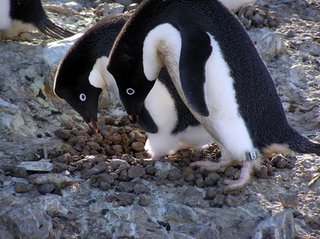 An Adelie penguin with a GLS tag (on its left leg) flirting with his mate. We deployed these tags last January, and they have been on the birds all winter. We have to remove them to download the data, which tell us approximately where the birds have been (in latitude and longitude) during their winter migrations. During the past three weeks we have also spent countelss hours trying to catch glimpses of the left legs of incubating birds, though we have a smaller pool to look at (20 tags in a small cluster of subcolonies, rather than searching the whole colony).
An Adelie penguin with a GLS tag (on its left leg) flirting with his mate. We deployed these tags last January, and they have been on the birds all winter. We have to remove them to download the data, which tell us approximately where the birds have been (in latitude and longitude) during their winter migrations. During the past three weeks we have also spent countelss hours trying to catch glimpses of the left legs of incubating birds, though we have a smaller pool to look at (20 tags in a small cluster of subcolonies, rather than searching the whole colony).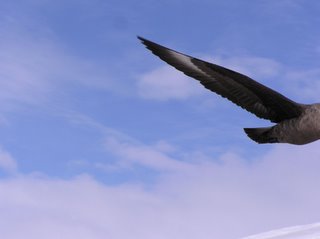 A South Polar skua flying by.
A South Polar skua flying by. Skua landing on the snow field above the west colony, with iceberg citadel and some open water in the background.
Skua landing on the snow field above the west colony, with iceberg citadel and some open water in the background.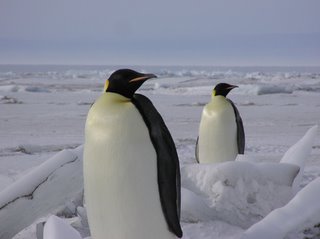 Emperor penguins on the sea ice.
Emperor penguins on the sea ice.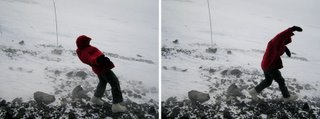 Vijay leaning into the wind and falling forward during a storm. The wind was blowing 40-50 mph.
Vijay leaning into the wind and falling forward during a storm. The wind was blowing 40-50 mph. Grant climbing over a snow cornice on the way to East Rookery.
Grant climbing over a snow cornice on the way to East Rookery. Adelies descending the snow field above the cornice, looking for a way down.
Adelies descending the snow field above the cornice, looking for a way down.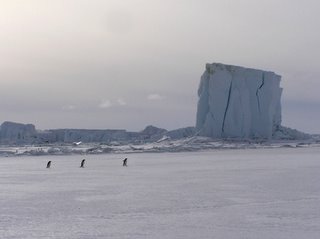 Three Adelies on the sea ice.
Three Adelies on the sea ice. Our Kiwi neighbors, Nick, Calum, and Jess, on the big rock in front of our hut. Their camp is 1.2 km away above East Rookery.
Our Kiwi neighbors, Nick, Calum, and Jess, on the big rock in front of our hut. Their camp is 1.2 km away above East Rookery.
Setting up the Weighbridge
 Grant and Vijay setting up the weighbridge sled.
Grant and Vijay setting up the weighbridge sled.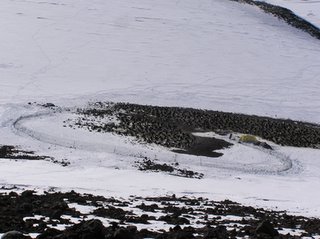 The weighbridge subcolony from above.
The weighbridge subcolony from above.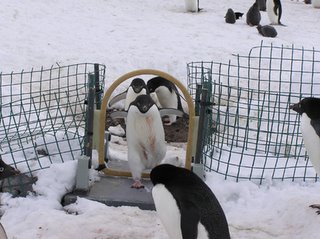
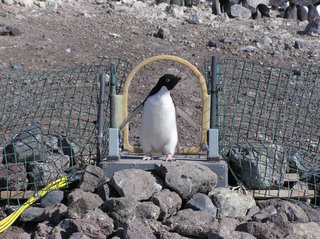
Adelie penguins crossing the weighbridge.On our very first day at Crozier (November 15th) we set up the wieghbridge, which is a scale with a magnetic hoop that wieghs and identifies penguins as they walk across it. The weighbridge is the only point of access to a fenced-in nesting subcolony, so each penguin from that subcolony has to walk across it to get to its nest and back out to sea. The bird is identified via a subcutaneous pit-tag that is automatically read by the magnetic hoop, just like a penguin fast-track. The data tell us when the each bird comes in and out of the colony and how much it weighs each time, and from the weight difference we can calculate, without having to handle the bird, how much food each one is bringing back to its chicks throughout the breeding season.Every year we have to haul the weighbridge itself, the WB computer, a big battery, and several rolls of fencing from the hut to the colony, which is 1 km downhill. We load everything on a banana sled and brave the icy snow field with our crampons, holding on to the sled with thick ropes to keep it from sliding all the way down to the sea ice. Dragging 250 lbs downhill along a snow field isn't too bad, but hauling it back up the hill at the end of season is always a good workout, especially when there is big sastrugi (wind-carved snow) in the way. Fortunately by that time, after two solid months of walking up and down the hill on a daily basis, we're in pretty good shape.
Cape Crozier
We have functional wireless at last! After much fussing, and thanks to Grant's hacking abilities, we were finally able to make our wireless internet link work. Grant Ballard, Vijay Patil, and I arrived at Cape Crozier on November 15th, 2005. For the past month we have been spending endelss hours searching for banded penguins in a colony of 250,000 birds. As of today, we have resighted 560 banded known-age Adelie penguins (i.e. banded as chicks), 288 of which have active nests. Most of them were banded at Cape Crozier, though a few came from other colonies from the other side of Ross Island. The first chicks started hatching late last week. Amelie Lescroel joined us yesterday and will be staying with us through the rest of the season, until late January. It's very late at night and there is too much to write, so I will start with a few photos from our flight to Cape Crozier on November 15th.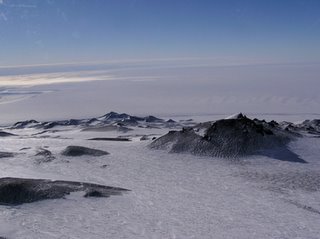 Flying along the southern edge of Ross Island. Ice covered mountains and the Ross Ice Shelf in the distance
Flying along the southern edge of Ross Island. Ice covered mountains and the Ross Ice Shelf in the distance View of Cape Crozier from the helicopter. The red arrow indicates the location of our hut. The colony stretches for 4 km along the shoreline. The iceberg B15-J is on the left side, separated from the Ross Ice Shelf by a channel filled with pack ice and small leads of open water.
View of Cape Crozier from the helicopter. The red arrow indicates the location of our hut. The colony stretches for 4 km along the shoreline. The iceberg B15-J is on the left side, separated from the Ross Ice Shelf by a channel filled with pack ice and small leads of open water.
Our home!



















